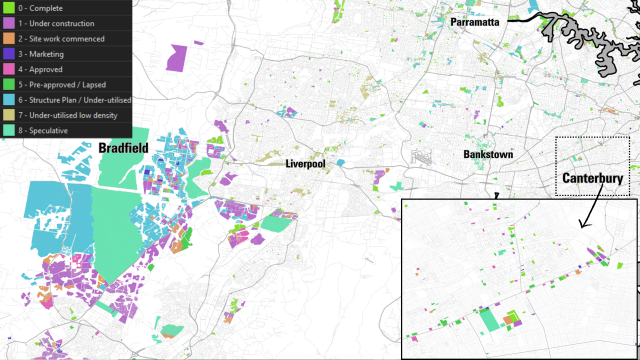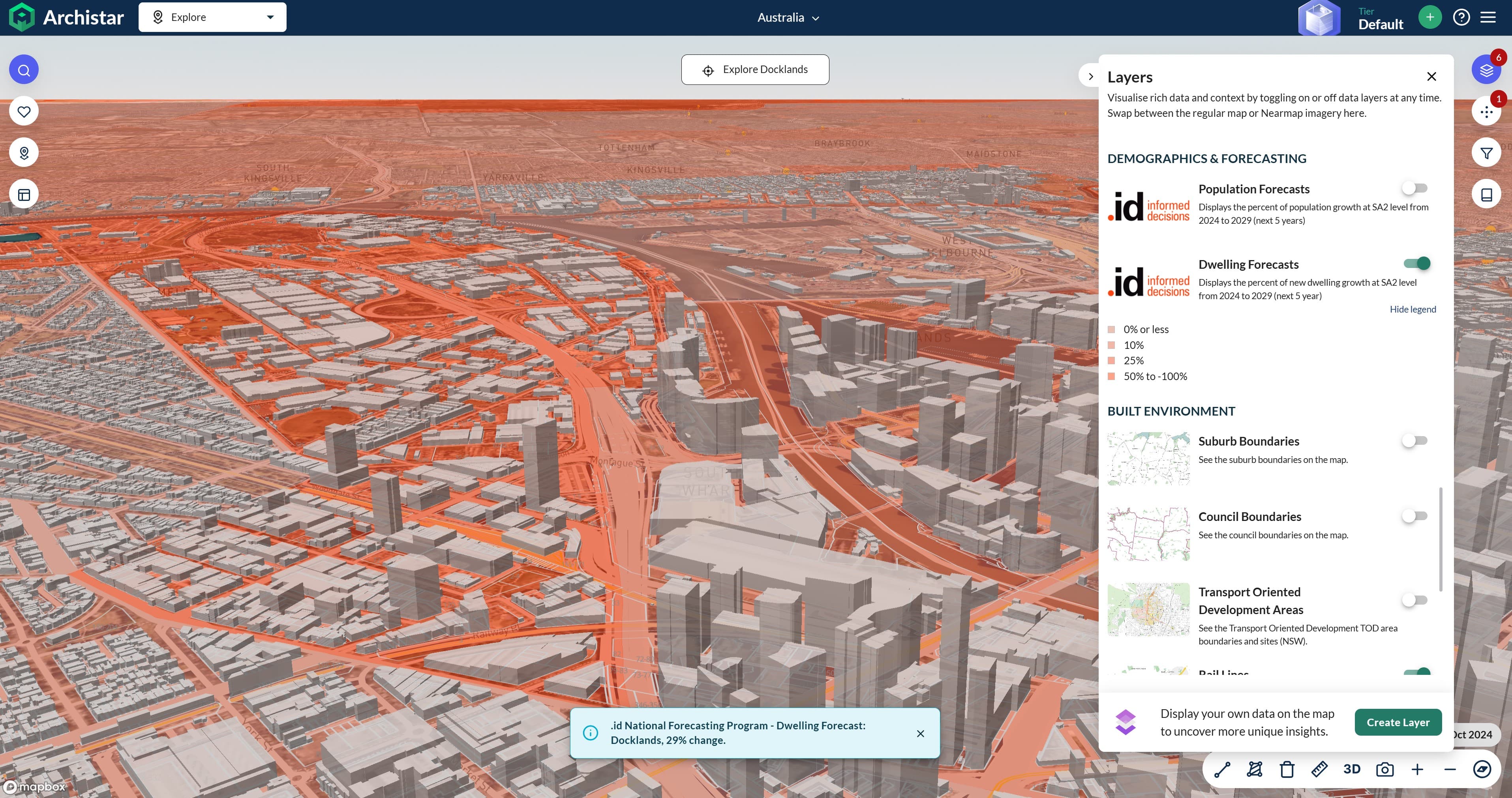BLOG
A return to the cities – what our nation-wide forecasts reveal about the future of Australia
A return to the cities – what our nation-wide forecasts reveal about the future of Australia
In October, we held a series of launch events to celebrate the fact forecast.id, our detailed, local area forecast of population, housing and development, are now available nationwide. In today’s blog, we share the main points from the keynote presentations at those events.
Now that we have a consistent, national forecast for the tens of thousands of unique local areas that make up our nation, what do these forecasts reveal? The big story: following a brief regional renaissance during the pandemic, is the return of population to our cities and urban centres. However, this surge places cities at the nexus of a critical tension—balancing population growth with the need to provide adequate housing supply, infrastructure and services.
Catch up on the photos, presentations and recordings from our recent launch events, or learn more about how forecast.id can help you invest in the right place, at the right time.
The population forecast for Australia
Over the next 25 years, Australia’s population will grow by 9.2 million people. This will take our total population to just under 35 million.

Australia’s population growth is driven by two key factors:
- Natural increase (the difference between births and deaths)
For many decades, natural increase has been the major source of our population growth. But more recently it has been steadily declining, largely influenced by our decreasing birth rate. Combined with improved life expectancy, this is leading to an aging population. - Net overseas migration (the difference between people migrating to and migrating from Australia)
During COVID, migration levels slumped due to heavy border restrictions. Immediately post the pandemic, there was a sharp surge in migration numbers. After this correction, net overseas migration is forecast to return to pre-pandemic levels. Over the next four decades, overseas migration is expected to add approximately 235,000 people to Australia’s population each year.
The impact of overseas migration
Australia is a migration nation. Population growth through overseas migration has a ripple effect on our:
- workforce
- skills base
- entrepreneurship
- innovation
- business growth
- international trade
- cultural diversity, and
- overall economic growth
The key to a successful migration program is maintaining high levels of living standards and social mobility. High-quality healthcare, education and working conditions all build social mobility and improve living standards. And so does access to affordable, decent housing.
Australia is already suffering a housing affordability crisis. Continued pressure on housing supply from population growth could threaten our ability to attract migrants. And this will have flow-on effects on productivity and economic growth in the longer term.
Across the public and private sectors, decisions are being made right now that will impact Australia’s liveability and attractiveness as a great place to live. Planning for these critical, high-risk investments needs to be informed by the most complete picture of the future we can predict.
forecast.id provides a national picture of housing supply mapped with population growth. It can tell us where and when population growth will happen nationally, all the way down to a granular forecast for individual suburbs and towns. This high-quality evidence base can inform such important location-based decisions that go to the heart of Australia’s identity as a place of opportunity for all.
A return to the cities
To reach 35 million in 2046, an average of 420,000 people will be added to Australia’s population per year. Where will these people live?
Approximately half of these people will be overseas migrants. Migrants tend to be students and skilled workers. These opportunities are more concentrated in the cities. And so migrants are more likely to settle in our cities. They also tend to be in the early stages of family cycles, and so will likely add to the population growth of our cities as they start having children.
There was an expectation that the COVID pandemic may trigger a ‘regional renaissance’. And there are some regional towns – like Ballarat in VIC and Orange in NSW – that have experienced strong population growth and will continue to do so.
But the big story from the national forecast data is that Australians are returning to the cities, and will continue to do so over the next 25 years.
The result is that the vast majority of Australia’s forecasted population growth will happen in the cities.
Where will the population growth happen?
At a macro level. the national forecast predicts:
- Australia’s four largest states (VIC, NSW, QLD, WA) will receive 93% of the forecast population growth
- Two-thirds of the total population growth will be in the Greater Capital Cities of Melbourne, Sydney, Brisbane and Perth
- Melbourne alone will receive 23% of the national population growth
- Sydney will receive another 18% of the national growth
- That leaves only 33% of the population growth spread across the smaller capital cities and regional areas
Many planning and investment decisions rely on understanding when and where growth will happen at a local level. And this is where the real value of the .id national forecasts lies. forecast.id allows us to inspect how macro trends will impact at very local levels – down to individual suburbs and towns, and even smaller parcels to enable analysis of custom forecast catchments.
So, let’s take NSW as an example. We know it will receive a significant portion of the national population growth. But we can also see how that macro trend will impact individual communities across the state.
Our national forecast is made up of over 57,000 individual building blocks across more than 15,000 suburbs nationwide. And we can zero in on each of those individual parcels to deliver highly localised forecasts, within the context of the suburb, state, and national trends.
The forecasts tell us more specifically that:
- 29% of the population growth in NSW will occur in the regions of Blacktown, Parramatta, the South West and Inner City
- The growth will be concentrated even further into specific suburbs like Leppington, Austral and Marsden Park
- Within Austral, we can also see that certain areas will receive higher levels of population growth than others
Forecast growth for Greater Sydney, where the darker red indicates areas of higher forecast population growth 2021-2041

Why is Bradfield forecast to grow by 15,000 people, while a similar-sized area in Canterbury is forecast to add less than 2000 people? The answer is, of course, housing supply.

Why would the spread of population growth differ so much between and within suburbs? For example, the above section of Bradfield will add over 15,000 new people, while a simliarly-sized area in Canterbury – closer to the CBD and potentially a more attractive place to live – will add less than 2,000 people?
The answer, of course, is housing supply. People go where there is somewhere to live.
Matching Population Growth with Housing Supply
forecast.id brings together population growth data with future housing supply to provide a more complete picture of where people will live in the future, and how this will impact the demand for infrastructure and services.
And not just where they will live, but when. Our forecasters gather information about all identified sources of housing now and over the next 25 years, and organise this research to indicate the timing and sequencing of future housing developments, considering both supply and demand drivers. Our assessments of future residential development are organised by categories such as
- Recently completed
- Under construction
- Approved
- Underutilised, and
- Speculative
This allows us to identify where the future population of Australia will live, and when housing supply will be available for them to live in.
A sample of the Residential Development Forecast layer, assessing the timing and sequence of future development, and underpinning our detailed population forecasts for local areas across Australia

The matching of population growth with housing supply is a powerful tool. It can be very useful in testing Federal and State policies. For example, the Victorian state government aims to build 800,000 new homes over the next 10 years. But our forecast predicts that – based on all potential sources of new housing – only 488,000 new dwellings will be built in that time.
This indicates that we are not building enough dwellings to meet future needs. And this will impact the government’s success in addressing housing affordability. The government will need to look at how it can encourage a significant increase in new residential developments, or risk falling short of the 800k target.
Summary
While achieving Australia-wide coverage with our detailed local area forecasts is an important milestone, the work to maintain this important national evidence base is ongoing. In the current high-migration environment, understanding the nuances of how the big-picture drivers of population change affect local areas in a detailed and nuanced way is critical to plan services and infrastructure in our cities and beyond.
Investment decisions need to be informed by an understanding of how macro trends will translate into state-level and localised impacts. The ability to drill down into the national forecast at such granular local levels allows forecast.id to produce an expert, independent assessment of the most likely future based on what we know today. And this helps our clients make better-informed decisions about location-based investments.
Of course, the story isn’t the same in all parts of Australia. Hear from our forecasters as they go behind the numbers to discuss what’s driving change in our detailed forecast analysis for unique regions or our regional webinar series. Or, learn more about the different ways you can use forecast.id to help you invest in the right place, at the right time.
Also published on Medium.









